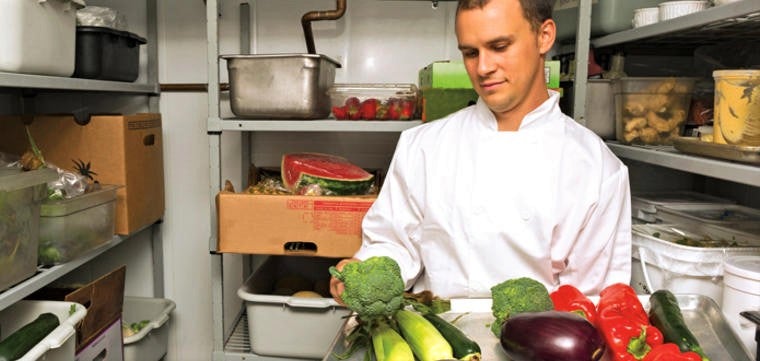7 Ways to Lower Food Costs in Your Restaurant
Food wastage is a costly business, as if running a restaurant weren’t a pricey enough enterprise in itself. With up to 40% of all food served in restaurants ultimately ending up in the trash – that’s somewhere in the region of 160 bn pounds annually – the problem of excess food going anywhere but the customer’s stomach is one worth an estimated $165 bn annually. Statistically speaking, over 25,000,000 people could be fed with the products saved from reducing wastage by just 15% – now that’s some food for thought.
Of course, no restaurant plates up their food with the intention for almost half of it to be thrown out, but the small scraps and gnawed-on pizza slices left can all add up to make a big difference. If you want to cut down on your restaurant overhead, as well as helping the environment by ordering what is actually consumed, there are plenty of ways to lower your food costs. Here are seven of the best to get you started.
Keep track of your inventory
Recognising just how much of your larder or walk-in fridge is being emptied over the course of a day is the best way to keep track of your inventory, so you can closely estimate whether or not you really need as much as you had originally ordered. While you should be doing so every couple of days, it’s best to check your stock at the beginning or at the end of the day, so you can see what you have in stock when the doors open, or to assess how much has been used at the end of trading hours. This is helpful for specific food items, especially if you find that you are using a lot less spinach, for example, than you thought you were: if it turns you have too much of it and that most of it is going to waste, cut back on your order the next time you process your stocktake.
Regulate portion sizes
This is best applied to pre-established menu items, as they will be ordered frequently enough for you to assess how much of the food is generally left untouched. If you find that around a third of your bacon and mushroom risotto winds up at the bottom of a trash can, consider investing in ladles or serving spoons that can measure out the amount of food that matches how much of it is actually being eaten. Make sure your chefs are kept up to date of any new regulations to your menu portions, to ensure they don’t continue to overserve customers and perpetuate food wastage.
Carefully calculate your food cost percentage
This may be a little bit of a tedious task, akin to filing your tax return, but like that annual chore this one is always very necessary, and will be sure to save you a lot of hassle in the long run. The process of calculating your food cost percentage factors in the scope of your inventory – do you have a lot of more costly organic food on your menu, or is there a balance of more commercially-sourced foodstuffs as well? – and the revenue generated from products sold. The optimal food cost percentage you’ll be aiming for is between 25% and 35%, but if you don’t hit that mark you needn’t worry too much, as your increased food costs may balance out in reduced staff payroll or other maintenance fees.

The formula for calculating this percentage is to divide the cost of goods sold by the total amount of your food sales, and then multiply that figure by 100. The end result will be your food cost percentage.
Utilize the FIFO (first in, first out) method
This one is pretty obvious and can be achieved with regular stock rotation: the first ingredients and foodstuffs you put into your pantries should always be the first ones to get used in your lunch or dinner service. Make sure you check the use by dates on every bag of salad or crate of tomatoes, and try not to shove things to the back of the fridge when you’re restocking. That’s how things get lost, go off, and ultimately get wasted. It’s worth noting that FIFO also means something else in industry slang – “full hands in, full hands out” – for which you can find the definition in our comprehensive A-Z glossary of food service terminology.
Make sure your staff are aware of the costs
This one is especially relevant to new staff, as you’ll want them to know how to prepare food properly and cut down on food waste. A large portion of ingredients are wasted during prep, as parts of vegetables or cuts of meat that could be used in a recipe are otherwise thrown out by an apprentice chef or inexperienced staff member who may not have mastered the art of food conservation. If they are informed of the costs incurred by wastage of a certain item, as well as educated in properly serving it, this can be a great way to reduce your overall food costs

Negotiate with your food suppliers
After you’ve established the rate of consumption within your restaurant, working out how much you need to order each month to cover the amount of food sold – as well as determining how much of it is actually eaten – you can then begin to shop around for suppliers who will give you better deals. Whether you request to have your products dispatched in bulk, or simply ask for a discount that will allow them to match the price of their competitors, it always helps to build a secure working relationship when trying to shave a few bucks off your invoice. This is something Buffalo Market is well-versed in, thanks to our established history of long-standing relationships with independent farmers. It’s how we’re able to provide you with the very best organic produce at most competitive wholesale prices.
Order based on the season
As certain items come into stock, market vendors and retailers will be keen to peddle their wares and take advantage of the new influx of exotic fruits or vegetables. This will be a great time to negotiate a bulk-buy deal and get a large order of valuable items for a favorable price. Alternatively, you want to keep an eye on what is happening with any climate-induced price hikes, as your menu’s need for guacamole may be poorly affected by a drought, say, that could greatly diminish that season’s avocado harvest. It pays to keep up to date with market fluctuations based on wider circumstances, to make sure you don’t take order of a product just as its price jumps up.
Running a restaurant can be a challenging and oftentimes confusing enterprise. Where to order in your stock, how to market yourself, how to keep up with customer demand as orders are split between diners in-house and at-home… There is no shortage of things to wrap your head around, regardless of what stage of your business career you’re at. Fortunately, at Buffalo Market we don’t just provide over 2,600 different kinds of top-tier organic produce at competitive prices in our massive inventory: we also offer guidance for the budding restauranteur with our very own restaurant owner’s blog.
Giving you insight into the latest food trends – such as the rise of plant-based meats and why you want your eggs with amber yolks – as well as tips on how to get your restaurant noticed, how to create a menu that will maximize turnover, and more general things to consider when opening a restaurant, our business blog is the best place to start as you turn that lifelong passion for food into a genuine moneymaking venture. Take a look today and see what tricks of the trade you can implement into your new business.


